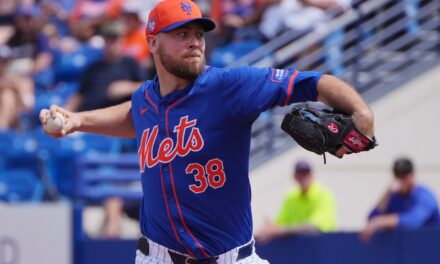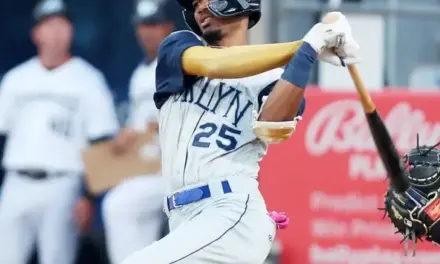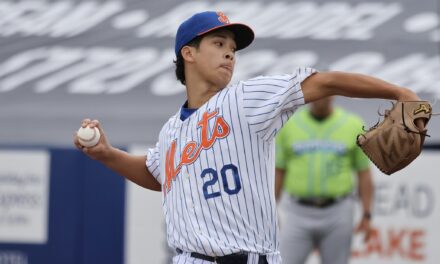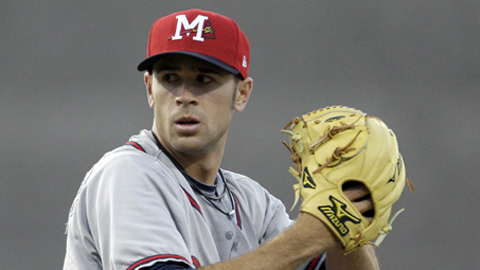
Anticipating the Rule 5 Draft can be like looking ahead to a trip to the dentist for an enthusiast of minor league baseball. Inevitably, players you have watched perform their trade, and, perhaps, even gotten to know a little when attending games at venues like Binghamton’s NYSEG Stadium are on the block, possibly lost to another franchise. To the minor league aficionado, the Rule 5 Draft is a time of foreboding, a time of dread.
Rule 5 dread and foreboding turned to loss for me this winter when two Met pitching prospects I had come to admire Logan Verrett and Greg Peavey were gobbled up in the draft. Both were critical pieces of the Binghamton baseball revival over the last two summers, Verrett going 11-5 in 2013, and Peavey, a pitching ace, amassing a stellar 11-3 campaign with a 2.90 ERA in the B-Mets championship season last summer.
I was especially distraught learning the Mets had lost Peavey. Greg is a standup guy I got to know somewhat last summer, a guest on the ‘All About Binghamton Baseball’ summer segment on my Tip-Off radio show.
But, the Rule 5 draft is a two-sided coin. On one side comes the hard felt loss of promising guys like Verrett and Peavey. But, with the other side of the coin comes gain, as baseball teams add other prospects with promise and possibility they pilfer from opposing franchises. For the Mets this winter that guy is Sean Gilmartin, a left-handed pitcher who last played in the Minnesota Twins organization. So, who is this guy Sean Gilmartin?
At 24 years of age, Sean Gilmartin has already experienced many of the highs and lows that come with playing baseball. Gilmartin grew up in Encino, California, a celebrated baseball star at Crespi Carmelite High School drafted in 2008 by the Padres in the 31st round. A kid who admittedly thought of little else but playing professional baseball, Gilmartin made the choice to forego a shot at the pros to attend college at Florida State.
It was a wise choice by the young left-handed pitcher, because it was at Florida State where Gilmartin’s baseball credentials blossomed. Almost immediately Gilmartin became an impact player for the Seminoles. A two-way star who played in the outfield when he wasn’t on the mound, Gilmartin became a ‘Friday night starter’ at Dick Howser Stadium for the Seminoles.
The Friday night starter on a college baseball team is reserved for a team’s ace, a trusted arm expected to bring home a win in the first game of a weekend three game series boosting the possibility of the home team taking the series. Friday night starters also get to pitch in front of their school’s biggest crowds increasing the visibility and interest of the baseball program on campus.
Gilmartin handled the pressures that come leading a famed Division I baseball staff well his freshman year going 12-3 with a 2.24 ERA. The lefty ace suffered from the sophomore slump in his second campaign struggling with a 9-8 record, but never lost his status as the Friday night man indicating how much respect he had gained for the Florida State coaches.
It was Gilmartin’s junior season as a Seminole that would accelerate his baseball career. The long legged left-handed ace was nearly unhittable going 12-1 with a 1.83 ERA and an impressive 0.94 WHIP. Gilmartin finished second in the ACC in strikeouts trailing the league’s MVP, Danny Hultzen, a second overall selection by the Seattle Mariners in the 2011 baseball draft. Hultzen, who missed all last season with a torn labrum, rotator cuff and anterior capsule, is making a pitching comeback that should see him back on the mound this season.
Gilmartin, too, went high in the 2011 draft, picked in the first round, 28th overall, by the Atlanta Braves. Long respected for finding pitching talent, it’s noteworthy any time a pitcher is selected in the first round of baseball’s draft by Atlanta. Braves scouts considered Gilmartin a quality left-handed pitcher with a great make-up and excellent pitch ability. They were impressed with the Florida State ace’s maturity and competitiveness on the mound.
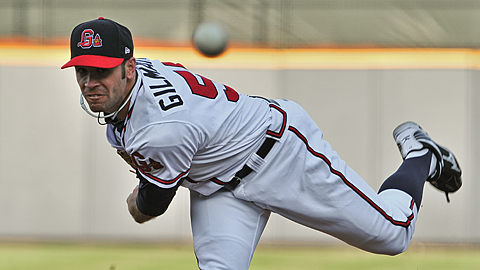
The Braves put Gilmartin on a speedy track through their minor league system with Gilmartin reaching their Triple-A team in Gwinett in his first year in the pros. But, Gilmartin never really caught on bouncing back and forth between Double-A and Triple-A with the Braves during his first two seasons as a pro. When the Braves were looking for added catching depth in the off-season last winter, they shipped Gilmartin to Minnesota for Ryan Doumit.
Splitting time between Double-A New Britain and Triple-A Rochester, Gilmartin put up the best pitching stats of his professional career in 2014. Gilmartin started 26 games going 9-7 with a 3.71 ERA and a 1.297 WHIP. Gilmartin’s strikeout numbers jumped, the lefty starter averaging 8.2 K’s per 9 innings with a SO/W ratio of 3.02, both the best in his pro career.
But, when the Twins shaped their 40-man roster prior to the Rule 5 draft, they decided to leave Gilmartin unprotected. The Mets jumped at the chance to add another left-handed arm to their pitching possibilities. Here’s what General Manager Sandy Alderson had to say about the addition. “There’s not really pronounced splits, so we don’t look at Gilmartin strictly left-on-left. But, we like his athleticism. We like his makeup. He’s got a chance to pitch against righties and lefties.”
Alderson may have liked the multiple possibilities that come with Gilmartin. A starting pitcher his entire career, Gilmartin could provide a left-handed possibility in the starting rotation if Jon Niese was moved in the off-season. And, as a former starter and someone with decent pitching splits, he could become a long reliever/spot starter on the Mets staff.
Gilmartin also could be used to face that one left-handed batter late in a game. Gilmartin pitched 23 1/3 innings against left-handed batters in Triple-A last year compiling a 0.75 WHIP, allowing no HR’s, and fanning 27 batters against just 3 BB’s. Left-handed Triple-A batters hit only .190 against him last season. It’s the multiple use possibilities of a guy like Gilmartin that probably drew attention from the Mets.
As a kid, Gilmartin lived for baseball and modeled his pitching style after three stellar left-handers Tom Glavine, Cole Hamels and Cliff Lee. That’s probably where Gilmartin developed his fluid, almost effortless pitching delivery. In some respects when he’s at work on the hill, baseball scouts report it almost looks as if Gilmartin is simply playing catch with the catcher’s mitt.
“I try to simplify things as much as possible,” Gilmartin told the Orlando Sentinel when he was first drafted out of Florida State. And, wherever he’s pitched, Gilmartin has been lauded for his maturity and poise on the mound. When asked about his ability to stay within himself and not show frustration when things don’t go as he intended on the hill, here’s how Gilmartin put it. “You can’t play the game that way. Baseball is a very failure-oriented sport. You have to know how to handle it.”
Gilmartin’s pitching philosophy is built around commanding his pitches. He has a four pitch repertoire to use in various situations. “The aspect of the game I am constantly working on is commanding all four of my pitches and being able to have the confidence to throw them in any count at any part of a baseball game,” Gilmartin told the Sentinel when he was just entering the pros.
Unlike the cadre of young power arms in the Met system, Gilmartin depends more on finesse, on pitching smarts, guile, and cunning to get professional baseball batters out. Gilmartin has a plan every time he goes to the mound with some well rounded options at his disposal. His fastball sits in the 87-91 mph range and runs in somewhat on right-handed hitters. Great command of the pitch both inside and out makes it a steady pitch selection for Gilmartin.
The change-up, a deceptive pitch thrown from the same arm slot as his fast ball and arriving at home plate at 79 or 81 mph, is Gilmartin’s bread and butter pitch. The change has great arm side fade and drop, and Gilmartin throws it at any count.
A high 60’s/low 70’s curveball has a significant break and 12/6 drop. Gilmartin throws the pitch consistently for strikes and uses it primarily against right-handed hitters. Against left-handed batter’s Gilmartin prefers to use his slider, a developing option with sharp, late break.
Gilmartin’s success lies with his ability to keep hitters off balance by mixing his pitches and commanding the strike zone. Gilmartin has to hit his spots to be effective.
A former number one draft selection, great athleticism, a left-handed pitching option, and maturity beyond his years make Sean Gilmartin a great gamble as a Rule 5 pick for the Mets. Expect the Mets to provide Gilmartin with every opportunity to prove he can help the big league team this spring.

